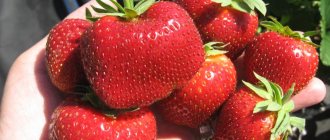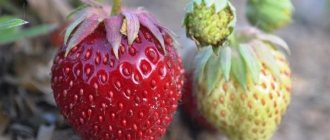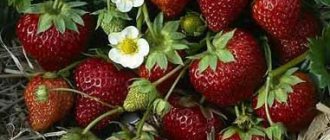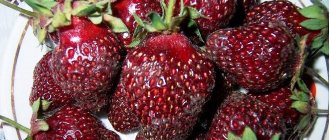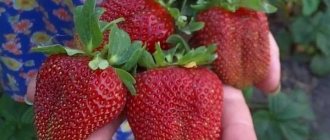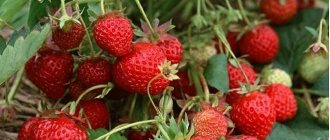Description
Capri strawberry bushes are of medium height. The leaves do not create a strong thickening. The flower stalks are strong and do not fall to the ground. The inflorescences attract bees with a large amount of pollen. A positive feature of the Capri variety is its long flowering. The berry grows large, weighing at least 40 g. The shape of the fruit is cone-shaped. The skin is glossy. The color is bright red with a burgundy tint. The nose of the berry at the stage of technical maturity is orange.
The pulp of the berry is quite dense, but this does not prevent it from being tender and juicy. The solid structure increases transportability as well as the safety of the fruit. This quality is highly valued by farmers who grow Capri strawberries for sale. The berry, even at the stage of technical maturity, contains a lot of sugar. The fruits do not lose their sweetness in rainy summers. The yield of remontant strawberries reaches 2 kg of berries per bush.
Attention! The Capri variety produces the largest harvest in the first and second years of life. Starting from the third year, the yield rate decreases.
The short peak in yield is due to prolonged fruiting. Strawberries ripen in waves from late June to mid-November. The berries deplete the mother bushes, shortening their life cycle.
Advantages and disadvantages of the variety
| Advantages | Flaws |
| Continuous long-term fruiting | The small number of whiskers complicates the propagation of the variety |
| High yield up to 2 kg per bush | The culture needs abundant watering and fertilizing |
| Bushes are frost-resistant, disease-resistant | Bushes develop well with frequent mulching and loosening of the soil |
| Berries can be transported and stored | |
| Compact size bushes | |
| The plant can withstand drought | |
| The sweetness in the berries remains in the rainy summer |
A feature of the Capri variety is the survival of the bush in the sun. The plant will remain alive even without shading, but there will be no flower stalks. Strawberries need plenty of watering to get a good harvest.
Strawberry variety Capri: video
This remontant variety, when grown under a film, bears fruit until winter.
The berries grow large and reach 40 grams. The place should not be swampy and light. Timely pruning, fertilizing, treating plants against pests and watering make it possible to increase the yield of Capri. In the first year, I was late with planting and the flowering of the bushes shifted by half a month, but in the summer these indicators evened out. The autumn berries turned out to be even tastier than the summer ones, although the size was slightly inferior. Every experienced gardener should grow a good and productive Capri variety.
Reproduction methods
Remontant strawberries of the Italian variety Capri are capable of propagation by tendrils, dividing the bush and by seeds.
Usami
A feature of the Capri variety is the small formation of mustaches. For caring for the garden bed, this is a plus, but with reproduction it creates a problem. However, there are mustaches, which means you can independently increase the number of bushes in the garden bed.
When the mother plant throws out a long tendril with a developed rosette, the soil is loosened between the rows. It is important to remove all weeds from the garden. The lower part of the rosette is slightly buried in the ground and watered frequently. By autumn the roots will grow. The rosette can be cut off from the tendril and replanted as a full-fledged seedling.
Dividing the bush
An adult plant at 2–3 years of age is propagated by dividing the bush. Strawberries are dug from the garden in the spring before flowering or in the fall after fruiting has ended. The bush is divided into several parts so that each rosette has at least 3 leaves and a developed root. Each Capri seedling is planted in a garden bed.
Growing from seeds
The Italian remontant variety Capri can be propagated or re-planted by seeds. You will have to grow seedlings in boxes, peat tablets or flower pots.
Attention! Detailed process of propagating strawberries by seeds.
In short, to obtain seeds at home, large overripe berries without visible damage are selected from the garden. The skin of the fruit is cut off with a knife, dried in the sun and the grains are collected.
The time for sowing Capri strawberry seeds is determined individually according to the weather conditions of the region. This is usually the period from February to early April. Before sowing, the seeds are subjected to stratification - cold hardening.
You can sow in peat tablets by soaking them in water beforehand. The traditional method is based on immersing grains in the ground. You can sow immediately in individual cups or in common boxes. In the second case, after three leaves have grown on the seedling, the plants are planted in a separate container.
Advice! It is undesirable to place strawberry seeds in a dense network in a common box. The sparse planting simplifies the picking process using the transshipment method. The plant is replanted with a spatula along with a lump of earth without damaging the root system.
If the strawberry seeds of the Capri variety do not germinate, it means that the technology for growing seedlings was violated. The problem can only be solved by re-seeding.
Vitamins and minerals
Strawberries are a source of many beneficial vitamins and minerals.
Vitamins
- A (improves vision, boosts the immune system, improves skin condition);
- C (reduces the risk of cancer, as well as cholesterol levels in the body);
- B1 (has a beneficial effect on nerve cells);
- B2 (improves the functioning of the gastrointestinal tract, improves vision);
- B6 (increases the production of endorphins);
- B9 (improves blood, increases memory ability);
- E (improves the condition of nails, skin, hair);
- K (reduces the risk of cardiovascular diseases);
- D (prevents the development of rickets).
Minerals
- potassium (reduces the risk of blood-related diseases);
- manganese (reduces the effect of toxic components on the body, promotes the absorption of iodine);
- copper (helps the body produce collagen, increases the number of red cells in the blood plasma);
- iron (forms red blood cells in the blood);
- silicon (reduces the influence of various types of bacteria on the body, makes tendons stronger);
- calcium (improves the condition of bones in the body);
- zinc (improves brain function, has an anti-inflammatory effect).
Additional substances
- oxalic acid, salicylic acid (give a diuretic effect, reduce the risk of blood clots, have a tonic effect on the body);
- ellagic acid (reduces the risk of cancer);
- bioflavonoids (have antibacterial properties);
- tanning elements (improve the condition of teeth, hair and nails);
- phytonutrients (kill various types of bacteria and viruses, help the immune system cope with diseases);
- phenolic substances (promote the absorption of vitamins);
- fiber (removes harmful substances from the body, improves the functioning of the gastrointestinal tract);
- pectin (removes toxins, reduces cholesterol, prevents the development of diabetes).
Landing
There are no special secrets to planting remontant Capri strawberries. The procedure is typical, as for all other varieties.
Attention! Read more about planting strawberries.
How to choose seedlings
High-quality seedlings of remontant strawberries of the Italian variety Capri are determined by their appearance. The horn of a good plant is at least 7 mm thick. The leaves are wide, juicy, without damage and at least three leaves.
The length of the open root system of the seedling must be more than 7 cm. If the plant is sold in a cup or peat tablet, inspect the entire lump. It should be braided with white roots.
Site selection and soil preparation
The Capri variety is not a demanding crop, but there are nuances in choosing the location and soil composition. Strawberries love loamy, fertile soils with neutral acidity. The plant will take root well in the area where alfalfa, green salads, and white cabbage grew last year.
Attention! The Capri variety cannot be planted in a bed where tomatoes, raspberries or other varieties of strawberries grew. The crop will grow poorly after potatoes.
The proximity of groundwater is detrimental to crops. If the area is swampy, create a raised bed for the bed. The Capri strawberry plantation is located in a sunny area. If it is impossible to provide good growing conditions, the crop can be grown in a vertical bed by planting the plants in flower pots.
Planting scheme
When planting seedlings of the remontant Capri variety, a space of 30 cm is left between the bushes. The width of the rows is about 45 cm. Since the variety forms few tendrils, dense planting of plants is allowed in order to save space.
Care
To get a good harvest, Capri strawberries need care. The procedures are all classic: watering, fertilizing, pest control, weeding.
Care in spring
Strawberries cause the gardener the most trouble in the spring. Caring for Capri involves the following steps:
- After the snow melts, the bushes are inspected. Pick off dry, damaged leaves and remaining old peduncles.
- Clear the bed of old mulch and winter shelter. Loosen the soil to a depth of 3 cm. Feed the strawberries with ash.
- If roots are visible on the surface, Capri strawberry bushes are spudded.
- In order for the plants to come to life and grow, strawberries are watered abundantly, starting in early spring.
- When it comes to feeding, Capri loves organic food. Under each bush, pour 0.5 liters of a solution of mullein 1:3 or chicken droppings 1:10.
- Before the buds have yet bloomed, strawberry bushes are treated for prevention with a solution of copper sulfate.
- The soil around the plants is covered with peat, sawdust or small straw. Mulch will retain moisture, prevent weed growth, and eventually become an organic fertilizer.
Strawberries definitely need mineral supplements in the spring. Saltpeter is usually used.
Watering and mulching
Despite its drought resistance, the remontant variety Capri loves abundant watering. Particularly a lot of water is required during the formation of berries and before flowering begins. However, the formation of swamps should not be allowed. After watering, the soil is mulched to retain moisture.
Fertilizing by month
During the season, the Capri variety requires three mandatory feedings with mineral complexes. The size of the berries and taste depend on this.
Attention! What and when to feed strawberries.
For your reference, a table is provided that describes preparations for strawberries and the technology for their use.
Preparing for winter
In autumn, strawberry bushes are prepared for wintering. Plants are provided with shelter from straw or pine branches.
Attention! Read more about preparing for winter.
Reviews
This is my fourth season of growing Capri. I will note a slight tearing of the berries; if you pull the berries, the berry comes off, and not the entire branch, as on some varieties. The berries are beautiful, they lie well, and when picked in the evening and sold the next day, they do not lose their original appearance at all. Productivity is good.
The variety is good. The berries are medium-sized, dark red, glossy. The taste is very sweet and aromatic. What I especially like is that overripe berries do not rot, but become like dried berries, and then dry out. Both dried and dried can be consumed, the taste is pleasant. The berries are easily torn off when picked, the leaves also break off very easily, which is convenient for autumn pruning and thinning. The peculiarity of the variety is its curved nose, which in Europe is called a cat's tail.
Capri strawberries are suitable for growing in home gardens and for commercial purposes on a large scale. To obtain the highest possible yields, it is necessary to follow the agricultural techniques that are used for remontant crops.
Features of growing in pots
The Capri variety can be grown in flower pots on a high bed or indoors. In the second case, artificial pollination with a brush will be required, and in the summer the strawberries are taken out onto the balcony.
Attention! Read more about the technology of growing strawberries in pots.
